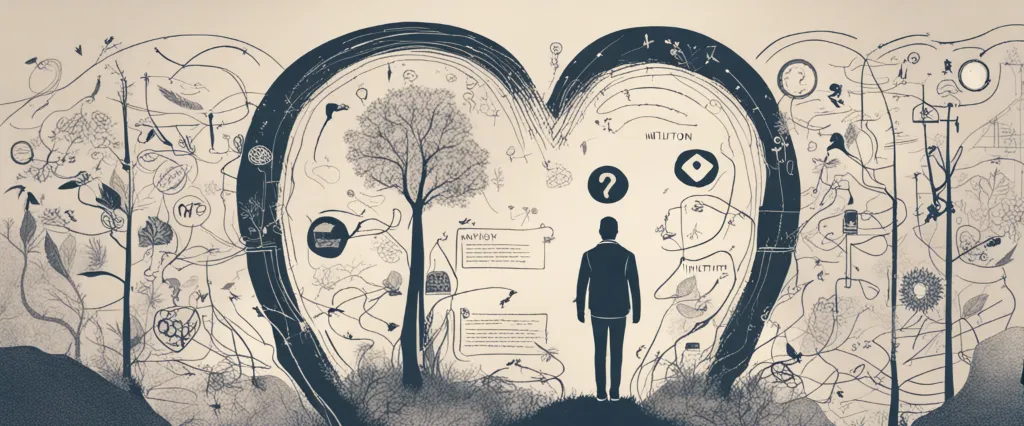Switch: Understanding Change Through the Heath Brothers' Insights
Chapter 1 What's Switch by Chip Heath, Dan Heath
"Switch: How to Change Things When Change Is Hard" by Chip Heath and Dan Heath explores the psychology of change and offers a framework for effectively implementing it in both personal and organizational contexts. The book presents a metaphorical model featuring three elements: the Rider (rational mind), the Elephant (emotional mind), and the Path (environment).
The authors emphasize that for successful change, all three components must be aligned. The Rider must provide clear direction, the Elephant needs motivation and encouragement, and the Path should be structured to make change easier to navigate. Through engaging anecdotes and practical strategies, the Heath brothers illustrate how to overcome resistance, create lasting change, and inspire others to embrace transformation. The book is a valuable resource for anyone looking to initiate meaningful change in their life or organization.
Chapter 2 Switch by Chip Heath, Dan Heath Summary
"Switch: How to Change Things When Change Is Hard" by Chip Heath and Dan Heath explores the dynamics of change and offers a framework for understanding how to effectively implement and sustain change in various contexts, from personal habits to organizational transformations.
The book is structured around a central metaphor of a rider (representing rational thought), an elephant (representing emotional drive), and a path (representing the environment or circumstances). The authors argue that successful change requires addressing all three elements:
1. Direct the Rider: This involves providing clear direction and guidance for the rational part of our brains. It is important to identify and articulate a clear vision of where you want to go and the specific steps needed to get there. This includes breaking down goals into manageable tasks.
2. Motivate the Elephant: Change is often resisted due to emotional barriers. To motivate the elephant, the authors suggest appealing to emotions, finding ways to create a sense of urgency, and using stories that inspire change. Engaging people's feelings can help overcome resistance and foster a commitment to change.
3. Shape the Path: Finally, the environment or context in which change occurs is crucial. The authors emphasize the importance of designing systems and processes that make change easier and more likely to stick. This might involve altering the physical environment, changing social norms, or providing support structures that facilitate progress.
The book also includes practical examples, case studies, and actionable strategies to illustrate how these concepts can be applied in real-life situations. Overall, "Switch" provides a comprehensive guide for understanding the psychology of change and offers tools for effectively managing transitions in various aspects of life.
Switch
Chapter 3 Switch Author
Chip Heath and Dan Heath are brothers and co-authors renowned for their contributions in the fields of business, psychology, and communication. They released their book "Switch: How to Change Things When Change is Hard" in February 2010. The book addresses the challenges of change and provides a framework for guiding individuals and organizations through the process.
In addition to "Switch," the Heath brothers have authored several other books:
1. Made to Stick: Why Some Ideas Survive and Others Die (2007) - This book explores why some ideas are more memorable and impactful than others, providing a framework for creating "sticky" messages.
2. Decisive: How to Make Better Choices in Life and Work (2013) - This book focuses on the decision-making process and offers strategies to overcome common biases and errors in thinking.
3. The Power of Moments: Why Certain Experiences Have Extraordinary Impact (2017) - This work discusses how to create meaningful moments in life and business and highlights the power of peak experiences.
As for which of their books is considered the best, it often depends on the context and audience. "Made to Stick" is particularly well-regarded for its practical application in marketing and communication, while "Switch" has been praised for its insights on change management. "The Power of Moments" has also received acclaim for its engaging storytelling and applicability in various settings. Each book may resonate differently depending on the reader's interests and needs, so there isn't a definitive answer as to which is the "best," as it is subjective.
Chapter 4 Switch Meaning & Theme
Switch Meaning
"Switch: How to Change Things When Change Is Hard" by Chip Heath and Dan Heath explores the psychology behind change and how individuals and organizations can effectively implement it. The authors use the metaphor of a rider (the rational mind), an elephant (the emotional mind), and a path (the environment) to illustrate how to encourage change.
Key Concepts:
1. Rider: Represents the analytical and rational part of the brain that plans and directs behavior. It needs clear directions and reasoning to function effectively.
2. Elephant: Symbolizes the emotional side that drives motivation and behavior. If the elephant is not motivated, change will be difficult.
3. Path: Refers to the external environment and context that affect behavior. Creating an easier path can facilitate change by reducing obstacles and providing clear guidance.
Main Ideas:
1. Direct the Rider: To initiate change, provide a clear direction. This involves:
- Clarifying the goals and the specific steps needed to achieve them.
- Focusing on what is essential, rather than overwhelming with too much information.
2. Motivate the Elephant: Engage people's emotions to increase motivation. This can involve:
- Telling stories that evoke emotional responses.
- Creating a sense of purpose and passion around the change.
3. Shape the Path: Alter the environment to support change. This entails:
- Making the desired behaviors easier to adopt by removing barriers.
- Establishing social norms and support systems that encourage the new behaviors.
Application:
The book provides practical strategies and real-life examples to illustrate how these principles can be applied in various contexts, such as personal development, organizational change, and social movements. By balancing the rational and emotional components of decision-making and paying attention to the context in which change occurs, individuals and leaders can foster more effective and lasting change.
Overall, "Switch" emphasizes that effective change requires not only clear guidance (the Rider) but also emotional engagement (the Elephant) and a supportive environment (the Path).
Switch Theme
"Switch: How to Change Things When Change Is Hard" by Chip Heath and Dan Heath explores the complexities of change and offers a framework for effectively managing it. The core theme of the book revolves around the idea that successful change requires aligning both rational and emotional aspects of human behavior.
The authors use a metaphor of a rider (the rational mind) and an elephant (the emotional mind) to illustrate the different components at play during change. The rider represents our analytical and logical side, while the elephant symbolizes our emotions and instincts. For effective change to occur, both must be directed in the same direction.
The book's main themes include:
1. Directing the Rider: Providing clear direction to guide the rational mind toward desired outcomes. This includes setting specific goals and breaking tasks into manageable steps.
2. Motivating the Elephant: Engaging the emotional side to create a sense of urgency and motivation for change. This can be achieved by tapping into people's feelings and making change feel attainable and worthwhile.
3. Shaping the Path: Creating an environment that facilitates change by removing obstacles and making desired behaviors easier to adopt. This involves altering the surrounding context to support new habits.
Overall, "Switch" emphasizes that understanding the interplay between reason and emotion, and manipulating the environment can lead to successful and lasting change, whether at a personal, organizational, or societal level.
Switch
Chapter 5 Quotes of Switch
Switch quotes as follows:
Here are ten notable quotes from "Switch: How to Change Things When Change Is Hard" by Chip Heath and Dan Heath:
1. "What looks like a people problem is often a situation problem."
2. "Change is hard because people are often stuck in the way they've always done things."
3. "Direct the Rider (the rational mind), motivate the Elephant (the emotional mind), and shape the Path (the environment)."
4. "The Rider is the logical, analytical side of our minds. The Elephant is the emotional, instinctive side. Together, they make up the Whole."
5. "To make change stick, we need to appeal to both the Rider and the Elephant."
6. "When you see the path clearly, it’s easier to motivate the Elephant."
7. "Find bright spots—instances of success in a sea of problems—and replicate those strategies."
8. "Success requires clarity of direction, emotional engagement, and an environment conducive to change."
9. "What seems impossible may just require the right approach."
10. "Small wins can lead to momentum, and momentum can lead to large changes."
These quotes capture the essence of the Heath brothers' insights on change and how to effectively manage it.
Chapter 6 Similar Books Like Switch
Certainly! Here’s a list of five thought-provoking books that explore themes of change, decision-making, and human behavior, similar to the themes found in Switch by Chip Heath and Dan Heath.
1. "Influence: The Psychology of Persuasion" by Robert B. Cialdini
This classic book delves into the psychology behind why people say "yes" and how to apply these understandings. Cialdini outlines six principles of influence that can help you understand how to persuade others effectively and ethically. It’s a must-read for anyone interested in marketing, negotiation, or simply improving their interpersonal skills.
2. "Nudge: Improving Decisions About Health, Wealth, and Happiness" by Richard H. Thaler and Cass R. Sunstein
Thaler and Sunstein introduce the concept of "nudging," which refers to subtly guiding choices without restricting options. The authors explore how small changes in the way choices are presented can significantly affect people's behavior and decision-making for the better. This book is essential for those interested in behavioral economics and public policy.
3. "Atomic Habits: An Easy & Proven Way to Build Good Habits & Break Bad Ones" by James Clear
Clear provides a comprehensive framework for understanding how habits work and how they can be changed. His method emphasizes the importance of tiny changes leading to remarkable results over time. The book is practical, filled with strategies to transform your habits, making it a valuable read for anyone looking to achieve personal growth and make lasting changes.
4. "Mindset: The New Psychology of Success" by Carol S. Dweck
In this influential book, psychologist Carol Dweck introduces the concept of the "growth mindset," the belief that abilities and intelligence can be developed through dedication and hard work. Dweck discusses the implications of adopting a growth mindset versus a fixed mindset, making this an inspiring read for those interested in personal development and education.
5. "Drive: The Surprising Truth About What Motivates Us" by Daniel H. Pink
Pink explores what truly motivates people in the workplace and life at large, challenging traditional views of motivation based only on rewards and punishments. He advocates for autonomy, mastery, and purpose as the three key elements of motivation, making this book a fascinating read for anyone interested in leadership, management, or personal fulfillment.
Conclusion
These five books offer valuable insights into understanding human behavior, fostering change, and making meaningful decisions. Whether you are looking to influence others, build better habits, or cultivate a more productive mindset, these titles will equip you with the knowledge and tools you need to thrive. Enjoy your reading!
Switch
Book https://www.bookey.app/book/switch
Author https://bookey.app/book/switch#Author
Quotes https://www.bookey.app/book/switch/quote
The Power of Habit https://www.bookey.app/book/the-power-of-habit
Youtube https://www.youtube.com/watch?v=qSnjIYZGUyc
Amazon https://www.amazon.com/Switch-Change-Things-When-Hard/dp/0385528752
Goodreads https://www.goodreads.com/book/show/6570502-switch


